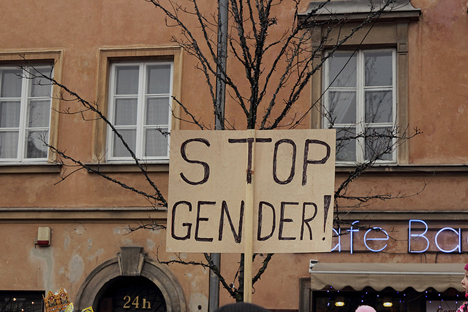
Neganthropology
Czas Kultury 2/2024
The politics and psychology of locality: on reviving local communities as high-tech expands and diversifies; forming networks against entropy; the Tortoise Strategy for caring; and rewriting life scripts.
An anti-gender campaign initiated by the Roman Catholic Church in Poland made gender a permanent fixture on the front pages of Polish newspapers as 2013 drew to a close. Karolina Wigura and Jaroslaw Kuisz introduce a new series of articles from Kultura Liberalna.
The English word “gender” entered the Polish language as a loan word, without any modification to its form. Although it certainly still sounds foreign, the word is hardly new to Poland. For at least two decades, many universities have run gender studies programmes, and numerous books on the subject have been published. From the second half of 2013 through to early 2014, however, the topic of gender barely left newspapers’ front pages.

A placard seen during a Catholic procession at the beginning of 2014. Photo: Lukas Plewnia,polen-heute.de/. Source:Flickr
Among scholars, gender studies are seen as supporting a wide-ranging and on-going discussion on the social roles of men and women, on the time they devote to housework and childcare, on the perception of equality and independence in marriage, and on gender equality policies, among others. It therefore came as a great surprise to university teachers and feminist and LGBT activists when senior and highly respected representatives of the Roman Catholic Church in Poland issued a series of controversial statements concerning gender. The clergy compared what they considered a harmful “gender ideology” to communist or totalitarian ideologies, drawing attention, for example, to the idea that a child is “not born, but produced”, an idea that they perceive this gender ideology to endorse.
Whenever the ensuing row seemed to have blown over, yet another pretext emerged for stoking it up again. After a series of controversial statements from representatives of the Roman Catholic Church, the media devoted its attention to the decision of Anna Grodzka, the first openly transgender MP in Poland, to join the parliamentary committee formed to put an end to “gender ideology”. The committee’s chairwoman, Beata Kempa of the rightwing conservative party United Poland, announced that it was Grodzka’s intention to “make a fuss”. And so the gender dispute blew up again.
The direction that the row over gender has taken so far is baffling, not least in terms of how sharply it diverges from the broader discussion outlined above. Neither does it seem to have taken into account in any genuine way the social teachings of the Roman Catholic Church after the Second Vatican Council. Further, the more rational and moderate arguments of centrist and liberal milieus have received little attention in the wake of numerous jokes, some more appropriate than others. At the same time as playing with a foreign-sounding word, tabloid newspapers printed scare pictures of hairy creatures intended as representations of the kind of demons that the word “gender” now supposedly summoned in the public’s imagination, accompanied by captions along the lines of “this is the face of gender”. This then triggered a bizarre competition among the creators of online memes.
So what is the fuss really about? What does the dispute really say about Polish society? Why does it produce such widespread emotion? What fears does it expose? Could it not simply be a reflection of the fear of the modern, typical of societies in transition?
One answer could be as follows: the gender dispute is political in character and was initiated by the Roman Catholic Church to hide its current problems. This is the diagnosis that Polish film director Agnieszka Holland suggests in conversation with Kultura Liberalna‘s Lukasz Pawlowski. Marcin Nowak from the Centre for Thought of John Paul II argues against this diagnosis in his conversation with Kultura Liberalna‘s Tomasz Sawczuk. Nowak contends that the discussion on gender stems from the Roman Catholic Church’s concern for the most intimate parts of our lives – those relating to carnality. He admits that communication on the part of the Roman Catholic Church has not been at its best on this issue.
Although much is often said about the Polish Church in the context of the gender dispute, attempts to analyse the Vatican’s stance are rare indeed. Piotr H. Kosicki is assistant professor at the University of Maryland. He specializes in the history of the Roman Catholic Church and is a permanent contributor to Kultura Liberalna. His analysis of John Paul II and Benedict XVI’s encyclicals leads him to some interesting conclusions that have remained for the most part marginalised in the Polish debate.
Published 28 March 2014
Original in Polish
Translated by
Ben Borek, Natalia Janota
First published by Kultura Liberalna 263, 4/2014, 21 January 2014 (Polish version); Eurozine (English version)
Contributed by Kultura Liberalna © Karolina Wigura, Jaroslaw Kuisz / Eurozine
PDF/PRINTSubscribe to know what’s worth thinking about.

The politics and psychology of locality: on reviving local communities as high-tech expands and diversifies; forming networks against entropy; the Tortoise Strategy for caring; and rewriting life scripts.

Expectations, standards, and requirements in higher education vary from country to country. In the third episode of the Knowledgeable Youth podcast Ukrainian students embark on the complex subject of tertiary education.